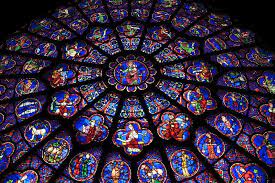With the Rev. Joseph Donnelly Council of the Knights of Columbus raising funds to restore windows at both St. Agnes and Our Lady of Perpetual Help Churches in Monmouth County, (see related story) it is interesting to know the necessity for preserving stained glass windows and their long history in religion as well as history, art and culture.
Stained Glass Windows
Stained Glass Windows. Created and designed from the time of the Greeks and Romans, they have been associated with churches and monasteries from the early days and admired for their utility and beauty throughout the centuries.
Stained glass began with the ancient civilizations who assembled small pieces of colored glass into small objects or designs using lead to blend the variety of colored glass pieces in a metal framework. The finished work told stories and by the 7th century, they were being produced in Great Britain, primarily in churches and monasteries.
Today, most stained-glass windows are in churches, many donated by family members in honor of a deceased loved one. Many, like in St. Agnes Church in Atlantic Highlands, tell a single story, or a group of stories. The four high windows in the sanctuary at Sgt. Agnes depict the four writers of the Gospels, Matthew, Mark, Luke and John.
At Our Lady of Perpetual Help Church, the dual church in the two-church parish, the prime window high behind the main altar is of Our Lady of Perpetual Help, the patron of the church and parish . All of the windows were donated by families dating back to the 19th century when the original church that preceded the current church was built and the parish was one of the first in the Diocese of Trenton.
Stained glass windows were popular in the Middle Ages, and by the 12th century the art of making stained glass windows was highly sophisticated. Chartres in France became the leading stained-glass manufacturer, with its workers earning the reputation of using only the finest materials. During the Reformation, many stained-glass windows in churches were destroyed, and replaced with plain glass, leading to the tradition of stained glass being forgotten.
A revival of the intricate and colorful work was revived in the 19th century as more churches were being built in the Gothic style and the windows were designed to exhibit scenes from the Bible and Saints. Buildings across Europe were restored, and a trend emerged for stained glass windows to be copied from famous oil paintings.
New techniques developed in the 20th century for creating glass, where pieces of stained glass overlapped, diminishing the number of leads.
Basic ingredients for making glass are sand and wood ash, mixed and melted into liquid. Before being blended with powdered metals added to create color. The molten glass is then blown into a sausage shape. The glass is then slit on the side, flattened into a sheet, and spun with an iron.
The design is made by arranging the different colored pieces on a design drawn over a board. In the case of fine details, or to create shadows or outlines, an artist paints these in with black paint.
Once the design is complete on the board, the pieces are fitted in strips of lead held to one another to keep the overall panel secure. Waterproofing is then added, and the finished product is then stabilized in an iron frame and mounted in the window.




Thank you for this beautiful, informative article. I learned so much.
Our Grandfather Emiel Aufieri, donated a stained glass window to the Episcopal church on Bay Avenue in Highlands in memory of our family. Grandpa owned a tavern on Bay and our Grandmother was very active in St Andrews.
As a French major in school, I never knew Chartres role in stain glass. Again Merci.
Comments are closed.